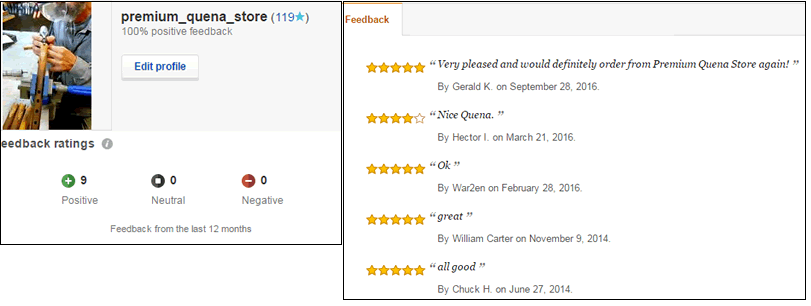About Us
Our mission is simple: to provide the best quenas, zamponas, flutes, charangos, and service to our customers at the lowest prices possible.

There are a lot of options out there but we have searched high and low to find the best flutemaker in terms of craftsmanship and acoustics know-how. The flute maker we have chosen, Angel Sampedro, has a long track record making bamboo and wood instruments. He has been recognized by the Argentine Association of Instrument Makers and has participated in acoustic research.
The quena we offer at the moment is only available through Amazon. Follow the link here to get your quena
We take great pride in our company, our commitment to customer service and in the products we sell. Our online store is designed to provide you with a safe and secure environment to browse our product catalog.
Our Brands
We are the exclusive distributors of the following brands in the USA:
- Un Mundo de Bambu

- Federico Tarazona
- Wayra PuKuna
- Ovcak

Buy with confidence.
Our company, based in Maryland, specializes in importing high quality musical instruments, specializing in quenas, quenachos, pan flutes, zamponas, sikus, maltas, shakuhachis, shakuquenachos, and charangos. We source the best instrument makers considering important metrics such as customer service, materials, experience, track record, innovation, and above all, professionalism.
We do not only sell on this page, our products are also sold on Walmart, eBay, Amazon, and Etsy.
Do not take our word for it, please read our ratings on each of these sites. Purchasing through this website provides you with discount opportunities that we cannot offer in other marketplaces. https://www.quenamall.com/pages/contact-us
Below see the ratings of our Amazon Store and eBay Store:

Payment Options
If you purchase through our website you have several payment options: We accept PayPal, and credit card payments. If you use PayPal you can finance your purchases for six months.
Feedback about our Premium Quenas made by renowned flute maker Angel Sampedro.
The [quena] has a softer tone, probably due to the bamboo and it being lighter. It is also breathier, but this might be me. I find its narrower embouchure harder to play. It is a little more balanced in volume between octaves than the Acha, but I find it a bit harder to play embouchure wise. The smaller finger holes still allow for expression, but are a little easier to close..." Paddler, Oregon on Chiff & Fipple's forum.
"[Quena] has an extremely sweet sound with some nice overtones. And I really like that groove he puts in the finger holes so the fingers lay in perfectly and it does make it easier for chromatics. It is a nice feature, a preference, and not at all necessary. [The]art work on the notch is always exquisite. Some of the larger bore instruments get into extreme stretch tuning where the top note can be a chromatic tone or more off and playing modern music with that can be difficult unless you adjust the playing angle.
So Angels quena's do have a very wide range of plus's and minus's. They might be a little challenging for beginners. Some of them I love and others I don't. I prefer Angels' his medium and larger bore but do have a a couple of his small bores that I used when I began.
I'd use Angels quena more for new agey stuff http://youtu.be/280dmeJmB8Q I played one of his chromatic quena's which is a little swiss cheesy but I wanted to try one." Hidancity, on Chiff & Fipple's forum.
Our quenas and tuning
Professional quenas are tuned up at a "saturated blowing point,” that is, just before switching to the second octave. The reason is that if they were tuned at a lower blowing point, a professional quena player could play it and say it’s out of tune. An out-of-tune quena can’t be fixed―or fixing it is complex―, while a quena that feels somewhat low can be corrected with practice. Now, it’s worth noting that this isn’t a defect in thequena; the same thing happens to other flutes made of metal.
The problem is that when you blow into a flute that is "low," either your teacher tells you that you are doing it wrong, or you yourself believe this, since it is an industrial instrument and you expect it to be well manufactured. With a quena, on the other hand, you blame the instrument.
It’s most probable that when you start playing a new type of quena or you are a beginner you get a "lowered" tuning, that is, a quena pitch that is a bit low. This depends on your embouchure, and you usually solve this by opening the embouchure. You would try to move the "U" and the edge of the mouthpiece away from your lips. At that position, the instrument has the right body and volume.
It is also possible to tune it up by blowing faster. This doesn’t mean you blow out more air, but blowing at a greater speed.
Below is a video demonstrating a tip to reach the third octave of B. x closed ; o open
Play A using this fingering: x xxo oxo and from this position go to B: x xoo oxo